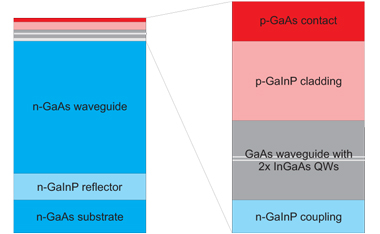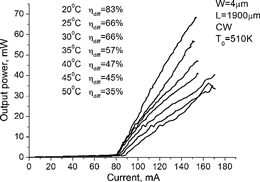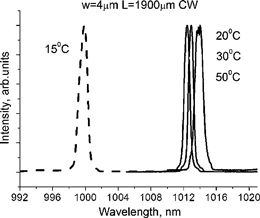
| Home | About Us | Contribute | Bookstore | Advertising | Subscribe for Free NOW! |
| News Archive | Features | Events | Recruitment | Directory |
News
18 February 2010
Tilting at higher laser temperature stability
Russian and German researchers have produced edge-emitting lasers with much improved temperature stability of wavelength and threshold current [N Yu Gordeev et al, Semicond. Sci. Technol., vol25, p045003, 2010].
Temperature stability is desirable for diode lasers that operate in varying temperature conditions for applications such as telecom and datacom transmitters, frequency conversion and solid-state laser pumping. Normal edge-emitting lasers can have significant red-shifts occurring over a few degrees since the wavelength tends to be determined by the energy bandgap, which tends to narrow at higher temperatures. If such a laser is being used to excite a gain medium in a diode-pumped solid-state (DPSS) laser, the efficiency of the system may drop dramatically as the diode goes off-wavelength.
The tilted-wave lasers (TWLs) produced by the Russian/German team have a separate cavity that determines the laser wavelength (Figure 1). Much better temperature stability is possible because the main source of wavelength shift is that of refractive index, whose effect is much smaller than that of the bandgap. A similar improvement in stability is seen in vertical-cavity surface-emitting lasers (VCSELs) for the same reason.

Figure 1: Schematic of tilted-wave-laser structure (left) with detail (right) of active region.
The researchers were based at two centers in St Petersburg, Russia, and one in Berlin, Germany: Ioffe Physical-Technical Institute, Academic Physics and Technology University, and Technical University of Berlin. Funding was provided by the European Union’s Seventh Framework (FP7) and various Russian programs and personal grants.
The laser structure was grown using metal-organic chemical vapor epitaxy (MOCVD) on n-type gallium arsenide (n-GaAs) (100) crystal orientation wafers. Two indium gallium arsenide (InGaAs) quantum wells (QWs) were grown inside a 600nm GaAs waveguide. The cladding and contact consisted of 600nm p-type gallium indium phosphide (p-GaInP) and 300nm of p-GaAs, respectively.
Beneath the active layer was a 10μm n-GaAs waveguide that was coupled to the active layer by a 250nm thick n-GaInP layer. This second waveguide was grown on top of a 2μm n-GaInP reflecting layer, grown on the substrate.
Broad-area lasers made from these wafers had threshold currents as low as 200A/cm2 and room-temperature lasing wavelengths in the range 964–1010nm, dependent on cavity length. The internal quantum efficiencies reached up to 84%, with intrinsic losses down to 2.2/cm.
Ridge lasers with 4μm wide shallow mesas were produced by etching through the contact and part of the cladding. The samples were mounted p-side down on copper heatsinks. Testing was carried out in the temperature range 15–60°C.
The far-field laser pattern has two weak satellite features in the lateral direction, but two lobes (around +30°, -40 \°) in the vertical direction. These characteristics are related to the way that the laser light leaks from the active region into the coupled waveguide at an angle and then is emitted from the lower waveguide facet.
 Figure 2: Temperature dependence of light-current curve.
Figure 2: Temperature dependence of light-current curve.
While the differential quantum efficiency (DQE/ηdiff) decreased significantly with temperature (Figure 2), the threshold current was much more stable. The characteristic temperature for the threshold current (T0) was more than 500K. This compares with T0 values for normal QW edge-emitting lasers of less than 200K.
The disparate behavior of the DQE and T0 may result from temperature dependence of mirror losses in the structure, but further investigation is required to confirm this.
The lasing wavelength shifts only 1.5nm in the temperature range 20–50°C (Figure 3). This gives a temperature coefficient (dλ/dT) of 0.05nm/K. This beats a recent report of 0.08nm/K for the lowest value for any broad-area semiconductor lasers without feedback gratings emitting above 900nm. Outside the 20–50°C range, the laser wavelength shifts by discrete amounts as new modes of the system become dominant: at 15°C the wavelength is 999.85nm, compared with the 20°C value of 1012.45nm.
 Figure 3: Temperature dependence of lasing spectra.
Figure 3: Temperature dependence of lasing spectra.
The researchers believe that the window of temperature stability could be increased by a broader gain spectrum and a wider separation between the matched TWL wavelengths by reducing the thickness of the coupled waveguide.
![]() Search: Edge-emitting lasers MOCVD GaAs InGaAs GaInP
Search: Edge-emitting lasers MOCVD GaAs InGaAs GaInP
Visit: http://dx.doi.org
The author Mike Cooke is a freelance technology journalist who has worked in the semiconductor and advanced technology sectors since 1997.